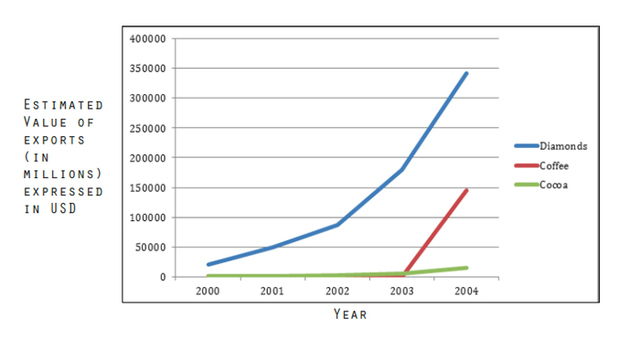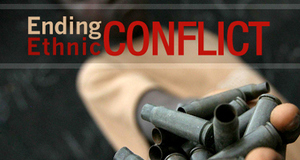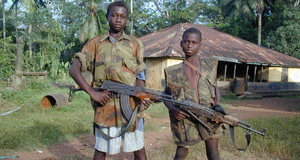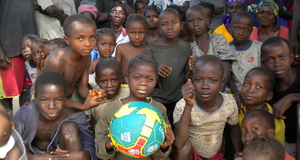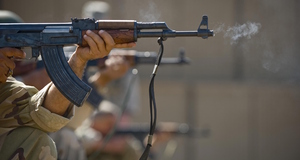From Cornell International Affairs Review VOL. 7 NO. 1Natural Resources and Prolonged Conflict: The Case of Sierra Leone
By
Cornell International Affairs Review 2013, Vol. 7 No. 1 | pg. 1/1
IN THIS ARTICLE
KEYWORDS
Why did Sierra Leone experience such a protracted civil war between 1991 and 2002? Sierra Leone has been beset with challenges since achieving independence from Britain in 1961, in particular its brutal civil war that resulted in tens of thousands of deaths and the displacement of almost a third of the total population. Yet Sierra Leone is now one of the more stable countries in West Africa due to its recently re-established democratic government and increasingly transparent, peaceful, and credible elections since 1996 following a series of turbulent regime transitions. This has finally resulted in the representation of multiple ethnic groups and political parties within the national government. Economically, however, Sierra Leone remains an extremely poor nation with tremendous income inequality despite its substantial mineral, agricultural, and fishery resources. As a nation heavily reliant on primary commodity exports (see graph on page 38), Sierra Leone continues to depend on alluvial diamond mining as its major source of hard currency earnings, accounting for nearly half of all exports (CIA World Factbook). Since diamonds are not prone to sudden depreciations in value, they are therefore a more stable form of currency than the Leone). In addition to its abundance in highly valuable natural resources, Sierra Leone boasts an ethnically diverse population with multiple prominent ethnic groups, each predominantly occupying a particular region and possessing a unique cultural history and language. The dependent variable examined in this paper is civil war. In particular, it seeks to investigate what factors led to the brutal eleven-year civil war in Sierra Leone. The lengthy duration of conflict in Sierra Leone is an atypical case as it exceeds the average nine-year duration of armed conflict for countries in Sub-Saharan Africa between 1945 and 1999.1 However, the causes for this inconsistency are not readily apparent, because Sierra Leone— like its Sub-Saharan African neighbors—also possesses significant ethnic diversity and has experienced repeated regime transitions (see graph on page 38 for estimated ethnic group population shares). During the course of the eleven-year civil war, Sierra Leone underwent multiple regime transitions among different forms of authoritarian rule, from one-party systems to military regimes, before the ultimate emergence of a democratic administration.This paper argues that Sierra Leone's protracted civil war during the 1990s cannot be accounted for by common explanations regarding the causes of protracted civil wars, such as ethnic diversity or a weak government during a period of regime transition. Instead, the prolonged nature of the civil war can be attributed to the presence of highly valuable natural resources and Sierra Leone's heavy dependence on these primary export commodities. Natural resources are therefore the main independent variable in this paper, in particular, the presence of easily extractable natural resources. These resources led to a prolonged civil war because they provided the rebel movement, comprised of Liberian and Sierra Leonean insurgents substantially supported by Liberian President Charles Taylor, with easily lootable assets and convenient sources of funding for sustaining the conflict.2 The availability of certain commodities that are either highly valued or geographically concentrated, such as diamonds in the case of Sierra Leone, creates opportunities for predation by rebels. Rebels are able to use force to loot and tax such commodities, thereby enabling rebel movements to acquire a source of sustainable financing that can be used to perpetuate conflict.3 Existing ExplanationsSome scholars hypothesize that the presence of a weak government during a period of regime transition may prolong civil war because insurgents are better able to thrive if the government and military to which they are opposed are relatively weak.4 A weak government is defined as one that is badly financed, organizationally incompetent, corrupt, politically divided, and poorly informed at the local level.5 However, this explanation does not sufficiently explain Sierra Leone's prolonged civil war between 1991 and 2002, because Sierra Leone did not experience civil war between 1978 and 1990 despite multiple regime transitions and a series of weak governments during that period. Surprisingly, Sierra Leone has today become relatively stable due to its recently re-established democratic government and increasingly transparent, peaceful, and credible elections— implemented since 1996 during the height of the civil war conflict. Sierra Leone remains an extremely poor nation with tremendous income ineqaulity despite its substanial mineral, agriculture, and fishery resouces Moreover, despite multiple regime transitions throughout the eleven-year conflict, Sierra Leone's governments and military opposing the rebel movement cannot be considered particularly weak in terms of either corruption or organizational incompetence. This fact is exemplified by the Ernest Bai Koroma administration's multi-faceted efforts since 1997 to implement more transparent leadership in Sierra Leone. First, the administration sought to fight and prevent corruption by establishing an anti-corruption commission to investigate and prosecute suspect government officials. In addition, it initiated a wide-scale public sector reform program to reduce and prevent wasteful government spending. Since government administrations during the civil war had recognized and sought to tackle corruption and organizational incompetence while strengthening their capacity to impose regulations, Sierra Leone's prolonged civil war cannot be explained by the presence of a weak government during a period of regime transition. Other scholars hypothesize that an ethnically diverse population may prolong civil war because ethnic wars, defined as wars among communities in conflict over the power relationship existing between them and the state, appear to last longer than non-ethnic wars.6 The logic underlying this argument is that opposing communities in ethnic civil conflicts are believed to hold irreconcilable visions regarding the state's identity, borders, and citizenship. For this reason, opposing ethnic communities do not seek to control a state in which all ethnic groups accept the existing identity of the state, but rather seek to redefine—often through violent means—the very identity of the state itself. This, however, is not the case in Sierra Leone, a country in which none of the major ethnic groups, including Temne, Mende, Limba, or Kono, have sought to monopolize the identity of the state itself. Instead, these groups' political aim was to obtain equal political representation within the national government, a goal that has now largely been achieved. Sierra leone's prolonged civil war cannot be explained by the presence of a weak government during a period of regime transition Scholars also hypothesize that the protection of ethnic identity is much more closely associated with protecting political rights and supporting democracy than it is with economic gain. Therefore ethnic grievances are most likely to be exacerbated by a lack of political and civil rights, coupled with the state's inability to nurture diverse ethnic identities within its cultural and political system.7 But this explanation also fails to explain the cause of prolonged civil war in Sierra Leone, since multiple ethnic groups have been represented in national government since independence, and different ethnic groups are accorded equal political and civil rights. Finally, ethnic diversity is believed to be especially problematic for domestic stability if a single ethnic group accounts for forty to sixty percent of the overall population and is able to dominate the others. In such polarized societies, it is theoretically easier for insurgents to sustain a rebellion.8 However, ethnic polarization was not a factor during the Sierra Leone civil war, as no single ethnic group accounted for forty to sixty percent of the overall population (see graph on page 38). In summary, explanations based on ethnic diversity are insufficient to explain the prolonged nature of the civil war in Sierra Leone. Theoretical FrameworkSince financing is an important determinant of a rebel movement's viability, this paper hypothesizes that African countries that are highly dependent upon exports of a few primary commodities are more likely to experience prolonged civil war. This is because the availability of such commodities creates opportunities for predation by rebels. Specifically, rebels can use force to loot and then informally tax these commodities, generating funds that can be used to sustain rebel movements and ultimately prolong conflict.9 The presence of natural resources affects the length of civil war because it determines the rebels' ability to continue waging war and thereby prolong the duration of conflict. In particular, prolonged internal conflict is most likely to occur when rebels are able to tax resources that are immobile and geographically concentrated, such as minerals.10 The RUF destroyed schools like this one in their campaign to "restore power and wealth to the people" In addition, the availability of certain commodities that can be easily looted because they are highly valued or geographically concentrated creates further opportunities for rebel predation. Countries that possess valuable commodities like diamonds or gold are therefore at higher risk of experiencing prolonged conflict, because the opportunity to loot and tax such commodities not only enables but encourages rebels to sustain conflict. Enclave economies, defined as countries in which more than seventy-five percent exports consist of minerals, timber, or agricultural products, may uniquely enable rebels to continue fighting if they can control and obtain revenue from these exports.11 Prolonged civil war may be especially likely if rebels control enclave production, because their relative monopoly on funds earned enables them to acquire and maintain the labor force and equipment necessary to survive against government forces.12 Lengthy civil wars can only occur when rebel groups are able to sustain large organizations by securing the financial resources necessary to continue waging warparticularly through control of natural resources. Empirical EvidenceThe mechanisms through which natural resources affect the likelihood of prolonged civil war are illustrated in Sierra Leone's civil war. Because prolonged conflict is often motivated and enabled by predation of natural resource exports and valuable commodities, Sierra Leone is an ideal case to test this hypothesis due to its abundance of easily extractable natural resources, particularly diamonds.13 The availability of certain commodities that may be easily looted as a result of their value and geographic concentration creates opportunities for rebels to forcefully seize and subsequently tax them to fund continued insurgency. The causal mechanism linking natural resources to prolonged civil war is the costs of sustaining a rebel movement—especially labor and armaments—against government forces. In essence, this requires the rebellion itself to generate revenue.14 The circumstances determining a rebel movement's financial viability are thus incredibly important, since prolonged civil wars can only occur when rebel groups can sustain their large organizations.15 This is evident in the case of the Revolutionary United Front in Sierra Leone, the central rebel movement that opposed the government throughout the eleven-year conflict. It was only able to do so by profiting through trade in conflict diamonds, defined as diamonds originating from areas controlled by rebel forces opposed to a country's internationally recognized government. The Revolutionary United Front rebel movement in Sierra Leone initially coalesced in opposition to the elite and corrupt government, claiming that it sought to restore power and wealth to the people. But the prolonged civil war that resulted from the rebels' insurgency would not have been possible without the revenue it acquired by looting alluvial diamond mines throughout the country and placing high informal taxes on the revenue generated.16 Prolonged internal conflict is most likely to occur when rebels can tax immobile and geopgraphically concentrated resources The claim that enclave production is particularly likely to cause prolonged civil war appears true in the case of Sierra Leone. The country's many easily extractable natural resources, most notably alluvial diamonds, allowed the rebel movement to continue funding its operations and thereby sustaining the conflict.17 The Eastern and Southern regions of Sierra Leone are abundant in these diamonds, which are accessible to anyone with a shovel and sieve. The Revolutionary United Front was thus able to fund its military action through illicit trade in conflict diamonds. Specifically, the Revolutionary United Front used funds from alluvial diamond mines to purchase weapons and ammunition from neighboring countries such as Guinea and Liberia.18 The fact that trade in conflict diamonds prolonged the civil war in Sierra Leone is reflected by International Criminal Court's recent conviction of Liberian president Charles Taylor for his role in sustaining the conflict by trading weapons and military training for diamonds, thereby enabling the Revolutionary United Front to sustain its brutal campaign. Certain primary commodity exports, such as minerals, provide an ideal source of rebel financing because rebels can potentially enjoy huge profits by seizing control of geographically concentrated resources.19 This is certainly true in the case of Sierra Leone, an enclave economy in which minerals account for approximately eighty percent of total exports. Revolutionary United Front rebels were able to reap sizeable profits after capturing and holding diamond mines in the Southern and Eastern regions of the country. Prolonged civil wars are more likely to occur in countries that have enclave economies because rebels are able to continue fighting as long as they can obtain revenue from the enclaves under their control. Enclave predation is most likely when there is high asset specificity, geographic concentration of resources, and high-value products.20 President Ernest Bai Koroma with US President Barack Obama: A clear example of Sierra Leone's Attempts to Establish democratic traditions It is therefore no coincidence that the civil war in Sierra Leone began in the Eastern town of Koidu, where most of the county's diamonds are concentrated and a major traditional site of alluvial mining. During the latter half of the civil war, Koidu was controlled almost exclusively by Revolutionary United Front rebels who used brutal force to seize and tax diamonds extracted there.21 The presence of easily extractable diamonds provided a powerful incentive for the continuation of civil war violence, and the rebels maintained control of important mining districts such as Kono and Koidu by expelling thousands of civilians through brutally violent means.22 In addition to providing rebel movements with a source of continued funding, increasing evidence indicates that natural resources also prolong civil war by increasing levels of rebel violence. Some scholars argue this is because the resource base under rebel control affects the type of soldiers who are recruited.23 Rebels fighting in a resource-poor area tend to attract committed soldiers, whereas rebels fighting in naturalresourcerich-areas tend to attract opportunist soldiers who are less disciplined and use more indiscriminate violence.24 This holds true in the case of Sierra Leone, where the Revolutionary United Front rebels brutally amputated the hands, arms, and legs of tens of thousands of Sierra Leoneans with machetes throughout the conflict. The Revolutionary United Front indicated that a major reason for these actions was to prevent victims from mining alluvial diamonds, which rebels feared could have been used to support government forces and defeat their rebel movement.25 Sierra Leone's civil war provides abundant evidence about how rebel organizations generate revenue through the informal taxation of the rents on primary commodity exports, thereby enabling prolonged civil war to occur due to heavy economic dependence on natural resource exports.26 In Sierra Leone, the availability of natural resources provided insurgents with easily lootable assets to seize and a source of income for sustaining the rebel movement.27 The prolonged nature of the civil war in Sierra Leone can be specifically attributed to the presence of alluvial diamonds; illicit trade in these diamonds gave the rebel movement the resources it needed to sustain the conflict for an extended period of time.28 This conclusion suggests that if governments are able to prevent rebels from holding and taxing export enclaves, most of the motivation and necessary funding for rebel groups would disappear ConclusionSierra Leone's lengthy civil war between 1991 and 2002 presents two important findings for African politics. First, it demonstrates how the presence of natural resources prolongs conflict by providing easily lootable assets for rebel movements to seize and use to fund continued operations. Second, it suggests that the presence of natural resources affects the type of soldiers recruited and causes higher levels of violence likely to prolong civil conflict. These findings have important implications for African politics, especially given many African economies' dependence on natural resources. Contrary to existing explanations of ethnic diversity and the presence of weak governments during periods of regime transition, this paper argues that some of Africa's prolonged civil wars may be best explained by economic factors such as heavy dependence on export enclaves, which are vulnerable to rebel control and predation.29 Rebel organizations may be able to generate the revenue they need to sustain conflict through informal taxation of the rents on primary commodity exports, such as diamonds.30 This conclusion suggests that if governments are able to prevent rebels from holding and taxing export enclaves, most of the motivation and necessary funding for rebel groups would disappear, and disaffected groups may be unlikely to attempt such rebel movements in the first.31 Instead, isolated pockets of disorder might exist throughout a country, but they would be financially unable to sustain rebellion for long periods of time.32 References“CIA World Factbook.” CIA Library. Central Intelligence Agency, n.d. Web. 28 Sept. 2012. <https://www.cia.gov/library/publications//the-world-factbook/geos/sl.html>. Collier, Paul. “Primary Commodity Dependence and Africa’s Future.” Annual World Bank Conference on Development Economics 2003. New York: Oxford University Press, 2003. 139-62. Print. Collier, Paul, and Anke Hoeffler. “On the Incidence of Civil War in Africa.” Journal of Conflict Resolution (2002): 13-28. Web. 27 Nov. 2012. Elbadawi, Ibrahim, and Nicholas Sambanis. “Why Are There So Many Civil Wars in Africa? Understanding and Preventing Violent Conflict.” Journal of African Economies 9.3 (2000): 244-69. Web. 27 Nov. 2012. Fearon, James, and David Laitin. “Ethnicity, Insurgency, and Civil War.” American Political Science Review 97.1 (2003): 75-90. Web. 27 Nov. 2012. Gberie, Lansana. A Dirty War in West Africa: The RUF and the Destruction of Sierra Leone. Bloomington, IN: Indiana University Press, 2005. Print. Leonard, David K., and Scott Straus. “The Causes of Civil Conflict in Africa.” Africa’s Stalled Development: International Causes and Cures. London: Lynne Rienner, 2003. 57-82. Print. Sambanis, Nicholas. “Do Ethnic and Non-Ethnic Civil Wars Have the Same Causes? : A Theoretical and Empirical Inquiry (Part 1).” Journal of Conflict Resolution (2001): 259-82. Web. 27 Nov. 2012. Scarritt, James, and Shaheen Mozaffar. “The Specification of Ethnic Cleavages and Ethnopolitical Groups for the Analysis of Democratic Competition in Contemporary Africa.” Nationalism and Ethnic Politics 5.1 (1999): 82-117. Print. Weinstein, Jeremy M. Inside Rebellion: The Politics of Insurgent Violence. Cambridge: Cambridge University Press, 2007. Print. Image AttributionsBy Laura Lartigue [Public domain or Public domain], via Wikimedia Commons By Laura Lartigue (USAID Photo Gallery) [Public domain], via Wikimedia Commons By Official White House Photo by Lawrence Jackson [Public domain], via Wikimedia Commons GraphsSource: United Nations Department of Social and Economic Affairs: Statistics Division Endnotes
Suggested Reading from Inquiries Journal
Inquiries Journal provides undergraduate and graduate students around the world a platform for the wide dissemination of academic work over a range of core disciplines. Representing the work of students from hundreds of institutions around the globe, Inquiries Journal's large database of academic articles is completely free. Learn more | Blog | Submit Latest in Political Science |





